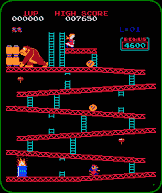|
Donkey Kong
Donkey Kong was the first arcade video game to feature multiple playfields. It was released in 1981 by Nintendo. In the game, your character "Mario" had to climb up a series of steel ladders and ramps and rescue his girlfriend "Pauline" from the clutches of the eponymous "Donkey Kong". To keep the insane, love-struck Mario at bay, Donkey Kong rolled barrels down the ramps at your Mario character, hoping to crush him. This was deemed a wise expenditure of pockets full of quarters in the early '80s.
Nintendo was in a previous life a company that made playing cards. When Space Invaders came along, Nintendo tried to create a clone called Radarscope. It was horribly received and Nintendo had a warehouse full of game cabinets. Shigeru Miyamoto was given the job of thinking up a game that could use the surplus cabinets.
Miyamoto was an artist
by trade and he started at Nintendo doing art work for game cabinets.
Nintendo made an intuitive leap. Games were not only being programmed by
programmers but designed by them. However capable a programmer was, they were
not always the best designers. Nintendo gave Miyamoto the green light to
design his own game. He started working on a game based on Popeye but the
deal for the rights fell through. He was then transferred to the Radarscope
rescue project. His work on Popeye had him thinking about a game along the
lines of the beauty and the beast motif. Miyamoto eventually came up with an
idea for a game about a giant gorilla that escaped from his irritating,
shrimpy owner. To exact revenge for his years of confinement, the ape kidnaps
his owner's girlfriend and climbs a series of buildings, challenging his
owner to catch him.
It's also been said the
main character didn't receive the name "Mario" until the release of
Donkey Kong Jr. This is partially incorrect. The character was first
identified only as "Jumpman". The name Mario appeared later in
promotional material for the original game. The name "Mario" came
from the name of the landlord of Nintendo's NYC HQ, Mario Segali. He
resembled the mustachioed character. The video incarnation of Mario was given
a mustache because of the low pixel resolution at the time. Nintendo couldn't
make a convincing mouth on the little man but a mustache showed up better. He
was given a hat for the same reason. It looked better than blocky hair.
-- Karl Mamer
|
